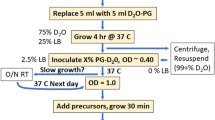Abstract
The discovery of the powerful magnesium isotope effect on enzymatic ATP synthesis provides a new insight into the mechanochemistry of enzymes as molecular machines. The catalytic activities of ATPase, creatine kinase, and glycerophsphate kinase containing a Mg2+ ion with magnetic isotope nuclei (25Mg) were found to be two to four times higher than those of the enzymes with spinless, nonmagnetic magnesium cation isotopes (24Mg or 26Mg). This demonstrates unambiguously that ATP synthesis is a spin-selective process involving Mg2+ as the electron-accepting reagent. ATP synthesis proceeds in an ion-radical pair consisting of an ADP oxyradical and Mg2+. In this process, the magnesium bivalent cation is the key agent that transforms the mechanics of a protein molecule into chemical processes. This ion is the crucial structural component of enzymes as mechanochemical molecular machines.
Similar content being viewed by others
References
Blumenfeld L.A. 1974. Problemy biologicheskoi fiziki (Problems in Biological Physics) Moscow: Nauka.
Oster G., Wang H. 2000. On the protein dynamics shift in enzyme catalytic activity control. J. Bioenerg. Biomembr. 32, 459–465.
Oster G., Wang H. 2000. Nucleoside inhibitors promoted conformational changes in prokaryotic phosphotransferases. Biophys. Biochim. Acta. 1458, 482–494.
Weber J., Senior A. 2000. The substrate binding site topology modifications in recombinant and intact metalloenzymes. Biophys. Biochim. Acta. 1458, 300–307.
Buchachenko A.L. 2005. Mechanochemistry of single molecules: New optical technologies. Usp. Khim. 74, 680–688.
Yasuda R., Noji H., Yoshida M., Kinosita K., Iton H. 2001. On the rotary mechanism in the bacterial ATP synthase functioning. Nature. 410, 898–904.
Noji H., Yoshida M. 2001. Potassium pumping in the ATP synthase activity affected by synthetic non-nucleotide inhibitors. J. Biol. Chem. 276, 1665–1671.
Sambongi Y., Iko Y., Tanabe M., Omote H., Iwamoto-Kihara A., Ueda I., Yanagida T., Wada I., Futai M. 1999. The eucaryotic ATP synthase rotary nanomechanics study. Science. 286, 1722–1727.
Rondelez Y., Tresset G., Nakashima T., Kato-Yamada Y., Fujita H., Takeuchi S., Noji H. 2005. The flexibility of the ATP synthase molecular motion and the reverse reaction control. Nature. 433, 773–777.
Oster G. 2002. Towards a novel approach to the energy turnover control in eukaryotes. Nature. 417, 25–29.
Blumenfeld L.A., Goldansky V.I., Podgoretsky M.I., Chernavsky D.S. 1967. Quantum-mechanichal resonance of energy levels in structural chemistry and biochemistry of macroergic nucleotides. Zh. Strukt. Khim. 8, 854–861.
Blumenfeld L.A., Temkin M.I. 1962. Electrophilic modification of nucleotide amino groups and its role in energy metabolism. Biofizika. 7, 731–737.
Blumenfeld L.A., Koltover V.K. 1972. Electron-acceptor processes in the functioning of the mitochondrial respiratory chain. Mol. Biol. 6, 161–168.
Buchachenko A.L., Kouznetsov D.A., Arkhangelsky S.E., Orlova M.A., Markaryan A. 2005. Spin biochemistry: mitochondrial phosphorylation as the magnesium-related nuclear spin selective process. Cell. Biochem. Biophys. 48, 886–894.
Buchachenko A.L., Kouznetsov D.A., Arkhangelsky S.E., Orlova M.A., Markaryan A. 2004. Magnetic isotope effect of magnesium nuclei in mitochondrial ATP synthesis. Dokl. Akad. Nauk. 396, 711–714.
Buchachenko A.L., Kouznetsov D.A., Arkhangelsky S.E., Orlova M.A., Markaryan A. 2005. Spin biochemistry: Magnesium-related magnetic isotope effect in mitochondrial ATP synthesis. Mitochondrion. 5, 67–70.
Buchachenko A.L., Kouznetsov D.A., Arkhangelsky S.E., Orlova M.E. 2006. On the search for magnesium nuclear magnetic isotope effect in direct and reversed reactions promoted by the Vipera xanthia creatine kinase. FEBS Lett. (in press).
Buchachenko A.L., Nikiforov G.A., Galimov E.M. 1976. Magnetic isotope effect of magnesium nuclei in phosphorylation reactions. Dokl. Akad. Nauk SSSR. 228, 379–383.
Buchachenko A.L. 2001. A survey on the chemical aspects in the nuclear magnetic isotope effect studies. J. Phys. Chem. A105, 9995–10004.
Buchachenko A.L., Kouznetsov D.A., Shishkov A.V. 2004. Spin biochemistry: A magnetic isotope effect of mercury in the methylmercury chloride reaction with creatine kinase. J. Phys. Chem. A108, 707–711.
Lahiri S., Wang P., Babbit S., Mcleish M., Kenyon G., Allen K. 2001. Dehydration of the creatine kinase nucleotide binding site in the enzyme function control studies. Biochemistry. 41, 13861–13868.
Tikhonov A.N., Pogrebnaya A.F., Romanovskii Yu.M. 2003. ATP synthases: Specific features of structure and activity regulation in eukaryotic cells. Biofizika. 48, 1052–1059.
Weber J., Senior A. 2003. Eukaryotic ATP synthases. Catalytic domains and the activity regulation. Brief review. FEBS Lett. 545, 61–65.
Cohn M. 1953. Oxygen transfer in oxidative phosphorylation: Orthophosphate and water participation study. J. Biol. Chem. 201, 735–738.
Merli A., Szilagyi A., Flachner B., Rossi G., Vas M. 2002. Pig kidney phosphoglycerate kinase: The catalytic site function. Biochemistry. 41, 111–118.
Flachner B., Kovari Z., Varga A., Vas M. 2004. Pig muscle phosphoglycerate kinase in the energy metabolism control. Biochemistry. 43, 3436–3441.
Author information
Authors and Affiliations
Additional information
Devoted to L. A. Blumenfeld
Original Russian Text © A.L. Buchachenko, D.A. Kuznetsov, 2006, published in Molekulyarnaya Biologiya, 2006, Vol. 40, No. 1, pp. 12–19.
Rights and permissions
About this article
Cite this article
Buchachenko, A.L., Kuznetsov, D.A. Magnesium magnetic isotope effect: A key to the mechanochemistry of phosphorylating enzymes as molecular machines. Mol Biol 40, 9–15 (2006). https://doi.org/10.1134/S002689330601002X
Received:
Issue Date:
DOI: https://doi.org/10.1134/S002689330601002X




